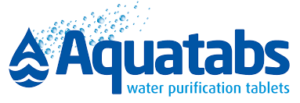Side Session Summary: Sustaining WASH behaviors and practices in healthcare settings
Published: July 23, 2018 / Published by Global Handwashing Partnership, Aquatabs, Amref Health Africa & Tufts University
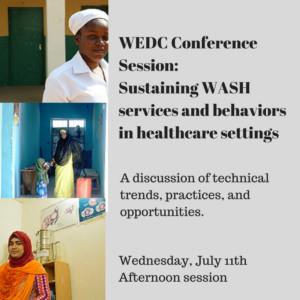
In this summary, we highlight the key messages and knowledge points from the roundtable discussion with partners and stakeholders on sustaining behavior and practices at the 41st WEDC conference.
At the 41st WEDC conference, the Global Handwashing Partnership, Aquatabs, Amref Health Africa, Tufts University, and World Vision convened a discussion on sustaining behaviors and practices for water, sanitation, and hygiene (WASH) in health facilities to improve patient safety and quality of care. This summary covers the key points from the presentations and discussions at the session, and all presentations are linked in titles.
Key messages:
- Poor WASH in health facilities leads to increased risk of healthcare-associated infections, antimicrobial resistance, and other major public health concerns
- Chlorine has many good uses in healthcare settings, and its use should be based on evidence
- Handwashing is a critical IPC practice in health facilities, and behavior change strategies can be used to improve currently low rates of hand hygiene compliance
- A comprehensive approach focused on WASH and IPC services and practices, including capacity building, can lead to short- and long-term improvements in health facilities.
- Leadership, collaboration, enforcement, and accountability are crucial elements of the enabling environment for WASH in health facilities.
WASH in health care facilities: Realities, issues and requirements
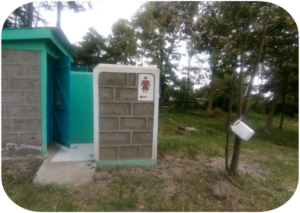 Beverly Mademba and Daniel Kurao of Amref Health Africa opened the session with a look at the global challenge of WASH in healthcare facilities. A 2018 study shows that 50% of HCFs in low and middle income countries lack piped water, 33% lack improved toilets, and 39% lack handwashing soap. Lack of WASH puts health workers, staff, and patients at risk, and contributes to newborn mortality, sepsis, anti-microbial resistance, and other key health concerns.
Beverly Mademba and Daniel Kurao of Amref Health Africa opened the session with a look at the global challenge of WASH in healthcare facilities. A 2018 study shows that 50% of HCFs in low and middle income countries lack piped water, 33% lack improved toilets, and 39% lack handwashing soap. Lack of WASH puts health workers, staff, and patients at risk, and contributes to newborn mortality, sepsis, anti-microbial resistance, and other key health concerns.
WASH in healthcare facilities for effective infection prevention and control (IPC) requires improvement of WASH services and IPC practices, maintenance and sustainability of existing services, and good governance. In Kenya, Amref covers a range of activities including: assessment of WASH infrastructure in health care facilities; sensitizing health workers and health management committees on sanitation and hygiene activities; supporting renovations of sanitation facilities and provision of hand washing facilities; continuous monitoring; and outcome and impact evaluation. Key lessons from their work include the need for: flexible budget allocations for WASH in HCFs, government-led collaboration, a broader infrastructure development agenda at health care facilities, and a focus on both hardware and behavior change.
Chlorine use in emergencies and outbreaks
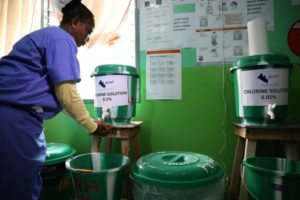 Chlorine is commonly used for disinfection in health emergencies, but there are conflicting guidelines on its ideal use. Dr. Justine Rayner of Tufts University presented the Lantagne Group’s recent series of projects on: chlorine chemistry and testing; surface disinfection; handwashing safety and efficacy; and chlorine tablet distribution. They found that titration had the highest accuracy and precision for chlorine testing, but test strips had the highest ease of use. Further test strip development is recommended. Shelf lives of .05% and .05% chlorine solutions ranged from several hours to more than 30 days, with the lowest shelf lives for neutralized NaOCl and NaDCC, and the highest for HTH and stabilized NaOCl.
Chlorine is commonly used for disinfection in health emergencies, but there are conflicting guidelines on its ideal use. Dr. Justine Rayner of Tufts University presented the Lantagne Group’s recent series of projects on: chlorine chemistry and testing; surface disinfection; handwashing safety and efficacy; and chlorine tablet distribution. They found that titration had the highest accuracy and precision for chlorine testing, but test strips had the highest ease of use. Further test strip development is recommended. Shelf lives of .05% and .05% chlorine solutions ranged from several hours to more than 30 days, with the lowest shelf lives for neutralized NaOCl and NaDCC, and the highest for HTH and stabilized NaOCl.
The Lantagne Group tested disinfection of E. coli and Phi6 (an Ebola surrogate) on multiple surfaces according to various international recommendations. They recommend 15-minute exposure to 0.5% chlorine for surface disinfection, independently of chlorine type, surface, pre-cleaning, and organic matter. Studies on the efficacy and safety of handwashing found that while all handwashing methods (soap, handrub, and four different chlorine solutions) were similarly efficacious, chlorine had an additional benefit of reducing contamination in rinse water. There were no significant differences in irritation or dermatitis, so responders should use what is available.
Handwashing behavior change in health facilities
 Research shows a strong link between health provider handwashing and increased maternal and newborn survival; reductions in healthcare-associated infections and sepsis; and improvements in patient safety, satisfaction, and overall quality of care. The World Health Organization recommends health workers clean their hands at five critical moments in addition to critical times for everyone, but an estimated 61% of health workers do not adhere to recommended hand hygiene practices.
Research shows a strong link between health provider handwashing and increased maternal and newborn survival; reductions in healthcare-associated infections and sepsis; and improvements in patient safety, satisfaction, and overall quality of care. The World Health Organization recommends health workers clean their hands at five critical moments in addition to critical times for everyone, but an estimated 61% of health workers do not adhere to recommended hand hygiene practices.
Carolyn Moore of the Global Handwashing Partnership presented evidence from the literature on drivers and interventions for handwashing behavior change in health facility settings. This includes access to visible, convenient soap or handrub and handwashing stations. While research shows a consistent gap between knowledge and practice of hand hygiene, conscious drivers can be leveraged through education and feedback, refresher training, and multimodal or multi-cadre training. Nudges can also be used as unconscious cues to improve hand hygiene practices. The Clean Clinic Approach is one example of efforts to build an enabling environment for behavior change. The approach uses checklists to help staff understand and monitor their own behavior, certification systems, and public results to create accountability, incentive, and demand.
Uganda WASH program in health facilities: World Vision Experience
 Dr. Fungai Makoni of World Vision provided a practical case study of World Vision’s work to improve WASH and IPC in health facilities in Uganda. Dr. Makoni also reviewed the standard precautions of IPC to protect patients, health workers, and visitors. World Vision recently assessed 52 facilities in Hoima District, Uganda, where 15.38% met basic standards for managing waste, 7.69% met basic sanitation standards, 9.62% had basic water supply, and 28.8% conducted cleaning routines.
Dr. Fungai Makoni of World Vision provided a practical case study of World Vision’s work to improve WASH and IPC in health facilities in Uganda. Dr. Makoni also reviewed the standard precautions of IPC to protect patients, health workers, and visitors. World Vision recently assessed 52 facilities in Hoima District, Uganda, where 15.38% met basic standards for managing waste, 7.69% met basic sanitation standards, 9.62% had basic water supply, and 28.8% conducted cleaning routines.
World Vision works with health facility staff to make immediate changes to WASH and IPC facilities and practices. This can include: re-locating waste bins for easy access; building or maintaining infrastructure, including incinerators; developing WASH check lists; building health providers’ skills; and supporting IPC committees. World Vision Uganda is piloting the Baby WASH approach, which combines interventions from WASH, nutrition, maternal, newborn, and child health, and early child development. Their ‘5S’ approach, focused on multiple aspects of WASH and IPC, has led to improvements in waste management, cleanliness, and key behaviors across facilities.
Discussion
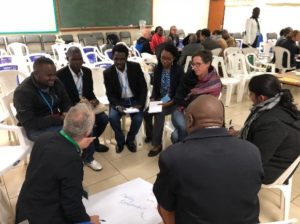 The group discussion, chaired by Kevin O’Callaghan of Aquatabs, focused on services, behavior change, and the enabling environment for WASH in health facilities. Key points from the discussion included:
The group discussion, chaired by Kevin O’Callaghan of Aquatabs, focused on services, behavior change, and the enabling environment for WASH in health facilities. Key points from the discussion included:
- WASH services need to respond to health workers’ and patients’ needs, and be convenient, well-maintained, and appropriate for the facility settings
- Incentives and accountability are powerful tools to support behavior change and prioritization of WASH
- There is an evidence gap on long-term sustainability of WASH behaviors in health facilities, but we cannot assume that behaviors will be sustained over time without reinforcement
- Policy and regulation, without enforcement, can become barriers. Participants emphasized the need to align WASH and health guidelines
- There is the potential for conflict between WASH and health actors if roles are not mutually agreed; many aspects of WASH in health facilities are led by health workers and health policy makers
- Hierarchies and a mindset of cure over prevention can be barriers to prioritizing WASH in health facilities
- Patient awareness and demand for WASH in health facilities are recommended to improve accountability
- IPC is not limited to health facility settings, particularly in health emergencies
- Lack of funding for health and WASH poses a major barrier to improving WASH in health facilities
- Leadership – at facility and policy levels – must be supported for long term success
Learn more
Please visit the World Health Organization WASH in healthcare facilities site and the Global Handwashing Partnership’s healthcare facilities page for additional tools and information. If you have other resources, ideas, and best practices for WASH in health facilities, please contact us.
Photo credits: Courtesy of Amref Health Africa; Nurse at redemption hospital washes her hands by World Bank Photo Collection licensed under CC BY-NC-ND 2.0; Christena Dowsett c/o Save the Children; Courtesy of World Vision Uganda; Courtesy of Aquatabs
Convening organizations:
- Resource Attachments:
- https://globalhandwashing.org/wp-content/uploads/2018/08/WASH-in-Health-Facilities_Amref-Presentation_11.07.2018-1.pdf (pdf)
- https://globalhandwashing.org/wp-content/uploads/2018/08/Chlorine_Emergencies_Outbreaks_WEDC-2018.pdf (pdf)
- https://globalhandwashing.org/wp-content/uploads/2018/08/Handwashing-in-health-facilities-002.pdf (pdf)
- https://globalhandwashing.org/wp-content/uploads/2018/08/World-Vision-WASH-in-HCF-in-Uganda.pdf (pdf)
TAGS: Trainings & ToolkitsResearch Behavior ChangeHygiene in Health Facilities ImplementersAcademicsAdvocates English 2018




